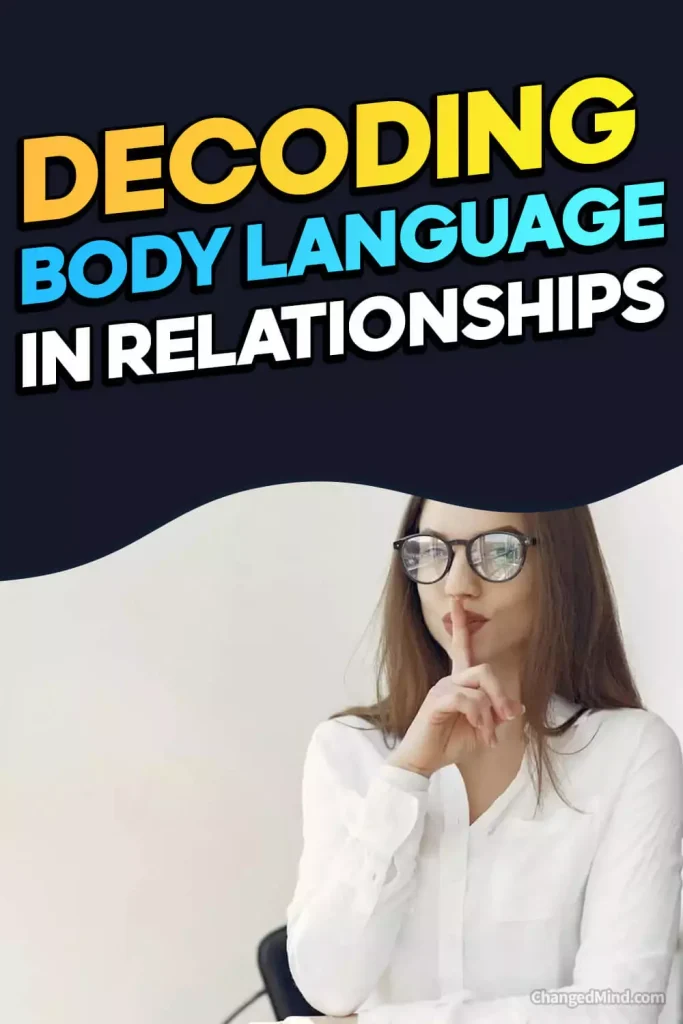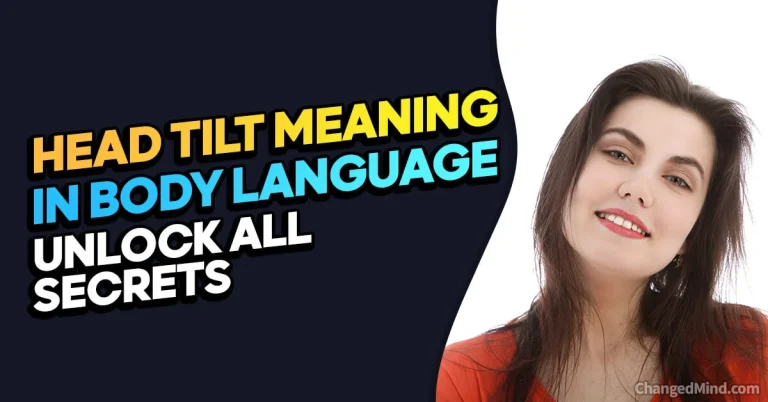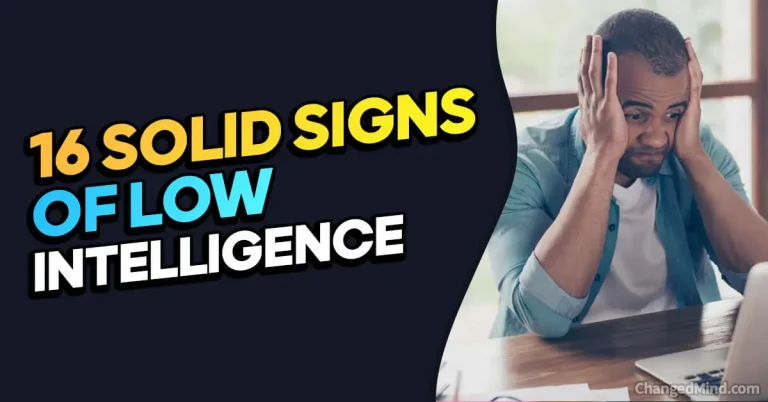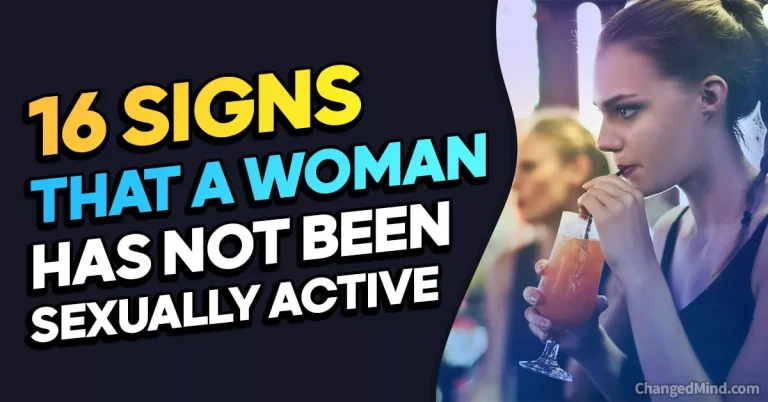Imagine this scenario: you’re sitting across from your partner at a cozy café, engaged in a seemingly pleasant conversation.
But as you pay closer attention, you start to notice subtle shifts in their body language—the way they cross their arms, the lack of eye contact, and the slight tension in their shoulders.
Suddenly, you realize that their nonverbal cues are telling a different story than their words.
Welcome to the intriguing world of body language in relationships, where gestures and expressions can speak volumes about your connection.
Key Takeaway:
- Positive body language signals in a relationship include smiling, making eye contact, mirroring body language, touching often, leaning in, laughing together, holding hands, giving compliments, and maintaining eye contact. These signals create a sense of emotional connection and intimacy between partners.
- Context is important in analyzing body language signals in relationships. Understanding the context, such as the setting and relationship history, can provide insight into the meaning of the body language being displayed.
- Negative body language signals in a relationship include a lack of eye contact, negative facial expressions, defensive body language, avoiding touch, standing apart, a lack of emotional connection, and stonewalling. These signals can indicate emotional distance, conflict, or disinterest in the relationship.
Nonverbal Cues of Attraction
Ah, attraction—the magical force that brings people together in a whirlwind of emotions and butterflies in the stomach. When it comes to decoding attraction, body language becomes an essential tool in our detective kit. So, let’s delve into the world of nonverbal cues that scream, “I’m into you!”
The Universal Signs of Attraction
Believe it or not, many nonverbal cues of attraction are universal. Across different cultures and backgrounds, our bodies seem to speak the same language when it comes to showing interest. Here are some of the signs to look out for:
- Eye contact: Ah, the eyes truly are the windows to the soul. When someone is attracted to you, their gaze tends to linger a little longer. So, if you catch your crush maintaining eye contact and peering deep into your eyes, there’s a good chance they’re feeling the spark too.
- Smiling: A genuine smile is worth a thousand words. When someone is attracted to you, their smile tends to be warm, sincere, and often accompanied by a twinkle in their eyes. So, if your conversation partner is flashing those pearly whites, it’s a positive sign that they’re enjoying your company.
- Mirroring: Have you ever noticed yourself unintentionally mimicking someone’s gestures or body language? That’s mirroring in action, and it often occurs when there’s a strong connection or attraction. When someone is attracted to you, they might subconsciously mirror your movements and postures. It’s like your bodies are dancing in sync, creating an invisible bond.
The Power of Eye Contact
Ah, eye contact—the Jedi mind trick of the dating world. It’s a potent tool that can convey attraction and interest without uttering a single word. Pay attention to these eye contact cues:
- Prolonged gaze: When someone is attracted to you, their eyes naturally linger on your face, soaking in every detail. So, if you notice your date gazing at you intently, they’re likely captivated by your charm.
- Dilated pupils: Have you ever heard the saying, “The eyes don’t lie”? Well, it turns out there’s some truth to it. When we’re attracted to someone, our pupils tend to dilate—a subconscious response that indicates heightened interest and arousal. So, if you catch your date with wide, dilated pupils, it might be a sign that they find you captivating.
The Art of Flirting Through Touch
Ah, the delicate dance of touch—a language all its own. When it comes to attraction, the way someone touches you can send electric jolts of chemistry through your veins. Here are some touch-related cues to keep an eye on:
- Light, lingering touches: When someone is attracted to you, they may initiate gentle, lingering touches on your arm, shoulder, or back. These soft caresses can create a sense of intimacy and connection.
- Proximity: Pay attention to how close your date stands or sits to you. When there’s mutual attraction, people often find themselves naturally gravitating towards each other, reducing the physical distance between them. So, if your date’s body is leaning in closer to yours, it’s a promising sign that they’re drawn to your magnetic personality.
The Dance of Mirroring
Ah, the art of mirroring—a subtle yet powerful signal of attraction. Mirroring is when someone unconsciously imitates your body language and gestures. It’s like a subconscious way of saying, “We’re on the same wavelength.” Look out for these mirroring cues:
- Gestures and postures: If your date subtly mirrors your gestures, such as crossing their legs when you cross yours or leaning in when you lean in, it’s a sign that they’re subconsciously trying to establish rapport and connection. Mirroring shows that they’re attuned to your movements and want to create harmony between you.
- Vocal tone and pace: Mirroring goes beyond just physical movements. When there’s a strong attraction, you might notice your date unintentionally matching your vocal tone and pace. It’s as if your verbal rhythms are dancing together in perfect sync.
So, the next time you’re out on a date or spending time with someone special, keep your eyes peeled for these nonverbal cues of attraction. Remember, actions speak louder than words, and our bodies have a way of revealing the unspoken desires of our hearts.
Body Language and Emotional Connection
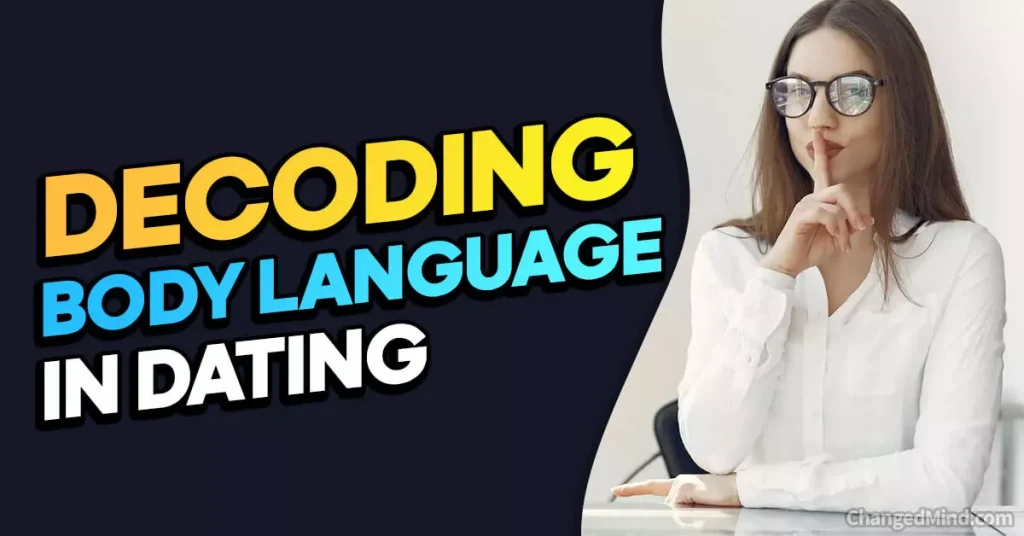
Have you ever experienced a moment where you felt an instant, unspoken connection with someone? It’s as if your souls recognized each other before your words had a chance to catch up. That’s the power of emotional connection, and our bodies play a vital role in expressing and reflecting that connection through body language.
The Subtle Dance of Emotional Connection
When two individuals share a deep emotional bond, their bodies naturally synchronize in a beautiful dance of nonverbal cues. Let’s explore some of the ways body language reflects and strengthens emotional connections in relationships.
The Language of Touch
Touch is a powerful form of communication. It has the ability to convey a range of emotions, from comfort and affection to passion and desire. Here’s how touch plays a role in expressing emotional connection:
- Affectionate touch: When you’re emotionally connected to someone, you’ll often find yourselves engaging in affectionate touch. This can include holding hands, cuddling, or gentle caresses. These acts of touch create a sense of closeness and intimacy, strengthening the emotional bond between partners.
- Supportive touch: In times of emotional distress or vulnerability, a gentle touch on the arm or a comforting hug can communicate empathy, understanding, and support. These gestures show that you’re there for each other, providing solace and reassurance.
The Power of Proximity
When you’re emotionally connected to someone, you naturally want to be close to them. Proximity, or physical closeness, is a clear indicator of emotional connection. Here’s how it manifests in body language:
- Physical closeness: When you’re emotionally connected, you’ll find yourselves naturally gravitating towards each other. Whether sitting side by side, standing in close proximity, or leaning into each other, physical closeness signifies the desire for emotional closeness.
- Shared personal space: Emotional connection often results in a blending of personal spaces. You may notice that you and your partner have a smaller bubble of personal space around each other compared to others. This overlap in personal space is a testament to the emotional bond you share.
The Power of Open Body Language
Open body postures are a visual representation of emotional openness and vulnerability. When you’re emotionally connected, you’ll naturally adopt open body language. Here’s what to look out for:
- Unguarded gestures: Open body language involves avoiding defensive gestures like crossed arms or crossed legs. Instead, you’ll find yourselves adopting more open and relaxed postures, such as keeping your arms uncrossed and facing each other directly.
- Facing each other: Emotional connection often prompts partners to face each other directly, making eye contact and fully engaging with one another. This facing behavior shows that you value each other’s presence and want to be fully present in the moment.
By paying attention to touch, proximity, and open body postures, you can gain a deeper understanding of the emotional connection within your relationship. These nonverbal cues create a visual symphony of love, trust, and vulnerability.
Remember, emotional connection is a two-way street. It requires both partners to be attuned to each other’s nonverbal cues and respond with their own authentic expressions. So, embrace the dance of body language, and let your emotional connection flourish through the unspoken language of touch, proximity, and open body postures.
Indicators of Trust and Honesty

Trust and honesty are the pillars of a strong and healthy relationship. In the realm of body language, there are certain cues that can help you gauge the level of trust and honesty within your connection. So, let’s dive into the world of nonverbal cues that signify trust and honesty in a relationship.
The Genuine Smile: A Window to Trust
Ah, the genuine smile—a universal symbol of warmth and authenticity. When it comes to trust, our smiles can reveal a lot about our intentions. Here’s what to look for:
- Duchenne smile: Named after the French neurologist Guillaume Duchenne, this genuine smile involves not only the muscles around the mouth but also the muscles around the eyes. A Duchenne smile, characterized by crinkling at the corners of the eyes, is a reliable indicator of sincerity and trustworthiness.
- Timing and duration: Pay attention to the timing and duration of your partner’s smiles. Genuine smiles tend to occur naturally and last longer, reflecting a sense of comfort and ease. If your partner’s smile lights up their face and lingers during your interactions, it’s a positive sign of trust and honesty.
Consistent Eye Contact: The Windows of Honesty
They say that the eyes never lie, and when it comes to trust and honesty, our gaze reveals a lot. Here’s what you need to know about eye contact:
- Sustained eye contact: Maintaining consistent eye contact during conversations is a powerful nonverbal cue that signifies trust and honesty. When someone trusts you, they’re more likely to meet your gaze directly and engage in meaningful eye contact.
- Eye contact during challenging conversations: During difficult or sensitive discussions, honest individuals tend to maintain eye contact even when the topic becomes uncomfortable. This behavior demonstrates their willingness to address difficult subjects openly and truthfully.
Open Hand Gestures: The Sign of Transparency
Our hands can communicate a lot about our intentions and openness. Pay attention to the following hand gestures:
- Open palms: When someone uses open hand gestures, with palms facing up or open and relaxed fingers, it suggests transparency and a lack of hidden agenda. Open palms indicate that they have nothing to hide and are willing to be vulnerable in the relationship.
- Reaching out: A willingness to extend a hand or reach out for physical contact, such as holding hands or a gentle touch on the arm, can also indicate trust and honesty. This gesture conveys a sense of connection and genuine interest in strengthening the bond between partners.
When you observe genuine smiles, consistent eye contact, and open hand gestures within your relationship, it’s a promising indication of trust and honesty. These nonverbal cues show that your partner is willing to be vulnerable, authentic, and transparent with you.
Remember, building trust and honesty takes time and effort from both partners. It’s a continuous journey of open communication, mutual respect, and integrity. So, keep an eye out for these body language cues as you foster a relationship grounded in trust and honesty.
Warning Signs of Toxic Relationships
In the realm of body language, sometimes our bodies speak louder than words. While nonverbal cues can convey warmth, trust, and connection, they can also reveal warning signs of a toxic relationship. It’s crucial to recognize and address these negative body language cues to maintain a healthy and fulfilling connection. So, let’s dive into the red flags of toxic relationships and the body language cues that accompany them.
Defensive Postures: Barriers to Communication
When communication breaks down in a relationship, defensive body language often takes center stage. These postures and gestures create barriers and hinder open and honest conversations. Look out for the following defensive cues:
- Crossed arms: Folding your arms across your chest creates a physical barrier, indicating defensiveness and a lack of openness. In a toxic relationship, crossed arms often symbolize resistance and an unwillingness to engage in meaningful dialogue.
- Turning away: When someone consistently turns their body away from you during conversations, it suggests disengagement and a lack of interest. It can be a sign that they are emotionally closed off and unwilling to address the underlying issues.
Expert Says
Dr. Jordan Schaul
Scientist with Degrees in Biology and Psychology | Founder, Scapegoat Strength

Lack of Eye Contact: Hiding the Truth
Eye contact is a powerful form of nonverbal communication that fosters connection and trust. In a toxic relationship, however, eye contact often diminishes or becomes uncomfortable. Look out for these signs:
- Avoidance of eye contact: When someone avoids making eye contact with you, especially during important discussions, it can indicate discomfort, dishonesty, or an attempt to hide something. Lack of eye contact in a toxic relationship reflects a breakdown in trust and open communication.
- Shifty or fleeting gazes: If your partner’s eyes dart around or frequently shift their gaze during conversations, it may suggest a lack of engagement or a desire to avoid confronting the issues at hand. This evasive behavior can contribute to a toxic atmosphere.
Closed-Off Gestures: Emotional Closure
In toxic relationships, closed-off gestures reflect emotional closure and a lack of willingness to connect or resolve issues. Keep an eye out for the following cues:
- Clenched fists: Clenched fists indicate tension and frustration. When someone frequently clenches their fists during interactions, it’s a sign of pent-up anger or aggression. In a toxic relationship, this can contribute to an atmosphere of hostility and emotional harm.
- Crossed legs: Similar to crossed arms, crossed legs create a physical barrier that suggests emotional closure and a lack of receptiveness. It can be a defensive posture that hinders open communication and understanding.
When these negative body language cues become prevalent in your relationship, it’s essential to address them. Toxic relationships can have severe emotional and psychological consequences if left unaddressed. Consider seeking professional help or engaging in open, honest conversations with your partner to address the underlying issues and work towards a healthier dynamic.
Remember, recognizing these warning signs is the first step towards creating positive change. Trust your instincts and prioritize your emotional well-being. A healthy relationship is built on trust, respect, and open communication, where both partners feel safe and heard.
Positive Body Language Signs in a Relationship
Positive Nonverbal Cues for a Healthy Relationship
Nonverbal body language is the unspoken communication that can reveal a person’s true feelings and emotions. Positive body language signals in a relationship play a critical role in understanding each other and building a healthy partnership. Here are six essential nonverbal cues that indicate a healthy and loving relationship:
- Eye contact – Looking into each other’s eyes while communicating shows respect and attention.
- Touch – Physical touch like holding hands, hugging or a friendly pat on the back reinforces a sense of security and love.
- Smiling – Smiling is a universal gesture of happiness and friendliness that can lighten up the mood and make people feel comfortable.
- Open body posture – An open body posture indicates that the person is receptive and is willing to listen, which is crucial in a relationship.
- Active listening – Nodding, mirroring, and responding reflectively while listening is a sign of respect, empathy, and understanding towards each other.
- Sharing spaces – Sharing space is a fundamental body language cue for couples, even in a tiny apartment. It signifies intimacy, trust, and comfort.
It is essential to recognize that each body language signal implies more than what meets the eye. For example, the way we stand, move, or sit can indicate a range of emotions such as confidence, anxiety, and defensiveness. Therefore, paying close attention to the context and patterns of behavior can reveal valuable insights for building meaningful relationships.
Expert Says
Professional Problem Solver and Relationship Expert | Author, “Toxic Person Proof: Clear the Confusion and Learn to Trust Yourself“

Pro Tip: Nonverbal communication is just as influential as verbal communication, which is why couples need to pay attention to nonverbal cues to build a robust and fulfilling relationship.
Context and Importance of Body Language Analysis
Body language plays a crucial role in analyzing and understanding communication patterns in relationships. Understanding the context and importance of body language analysis is vital in improving relationships. It is a nonverbal way of communication that can affect the message conveyed. Body language is a reflection of one’s emotions, attitudes, and personality traits.
Analyzing body language is essential in providing insight into relationships. Nonverbal cues, such as gestures and facial expressions, can reveal the subconscious thoughts and feelings of individuals. It can improve communication and decrease misunderstandings. Moreover, it is crucial in identifying deception and building trust in relationships.
Furthermore, body language analysis is an effective tool for professionals such as therapists, investigators and lawyers, in deciphering the dynamics of interpersonal relationships. It can help in revealing the true intent of the participants involved in a conversation without relying on words.
A study conducted by Allen, et al. (2019) stated that accurate interpretation of body language can often determine the success of an individual in social and professional settings. Knowing the context and importance of body language analysis can benefit individuals in improving their communication skills and building better relationships.
Negative Body Language Signs in a Relationship
Negative Signs of Body Language in a Romantic Partnership
It is essential to be conscious of the negative signs of body language in a loving relationship. These signs communicate a lack of attentiveness, passion, and esteem. Below are six indications that highlight negative body language signs in a romantic partnership.
- Avoiding eye contact
- Rolling eyes
- Standing with arms folded
- Leaning away from the other person
- Downcast posture
- Refraining from touch or expressions of affection
Additionally, silence or hesitant communication is a negative sign that something may be wrong. It’s crucial to understand these signs and devise ways to resolve the issues peacefully without further unrest.
There was once a couple who were distressed by the way they communicated with each other. They were constantly fighting over small issues, and they did not understand the reason for their problems. Over time, they realized that their body language demonstrated disinterest and dismissal. As they became aware of this, the couple began adjusting their body language and communication, which strengthened their relationship.
Being attentive and understanding negative body language signs can help improve communication in a relationship. Awareness of these signs encourages individuals to determine problems and negotiate solutions that work for both partners.
The Influence of Narcissism on Body Language
Ah, narcissism—the larger-than-life personality that often captivates attention but can leave a trail of emotional turmoil. Narcissistic traits can manifest not only in the way individuals behave but also in their body language. Understanding how narcissism influences body language can help you navigate relationships more effectively. So, let’s explore the telltale signs of narcissism through body language.
Grandiose Gestures: The Need for Attention
Narcissists have an insatiable need for attention and admiration. This craving often leads to grandiose gestures and behaviors that seek to command the spotlight. Look out for these signs:
- Exaggerated movements: Narcissists may display exaggerated gestures and movements to draw attention to themselves. They might use broad arm gestures, expansive postures, or dramatic facial expressions to create a sense of importance and captivate their audience.
- Dominant body positioning: Narcissists often position themselves in a way that conveys dominance and superiority. They may stand with an expanded chest, lean back to appear taller, or lean into your personal space to assert control. These power dynamics are reflected in their body language.
Lack of Empathy: Emotional Disconnect
One of the defining traits of narcissism is a lack of empathy and concern for others. This emotional disconnect is often visible in their body language. Pay attention to these cues:
- Limited mirroring: While mirroring is a natural way of building rapport and connection, narcissists tend to mirror others less frequently. They may not reflect your gestures, facial expressions, or body language, showing a lack of empathy and an inability to connect on an emotional level.
- Dismissive gestures: Narcissists may use dismissive gestures, such as eye rolls, smirks, or dismissive hand waves, to invalidate your emotions or opinions. These nonverbal cues reflect their lack of empathy and disregard for your feelings.
Dominance Displays: Establishing Power
Narcissists have a strong desire to assert dominance and control in relationships. This need for power is often exhibited through specific body language cues. Look for these signs:
- Intense eye contact: Narcissists may use intense and prolonged eye contact as a means of asserting dominance and challenging others. Their gaze may be piercing and unwavering, aimed at establishing a sense of control and superiority.
- Invasion of personal space: To assert dominance, narcissists may invade your personal space, getting uncomfortably close. They may use proximity as a way to exert power and make you feel intimidated or submissive.
It’s important to note that not everyone who exhibits these body language cues is a full-fledged narcissist. These traits exist on a spectrum, and it’s the pattern of behavior and their impact on your well-being that determine the presence of narcissistic tendencies.
If you find yourself in a relationship with a narcissistic individual, it’s crucial to establish healthy boundaries and prioritize your emotional well-being. Seek support from trusted friends, family, or professionals who can guide you through the complexities of navigating a relationship with a narcissist.
Remember, understanding the influence of narcissism on body language is an essential tool for self-protection and maintaining healthy relationships. Trust your instincts, prioritize your emotional needs, and surround yourself with those who value and respect you for who you are.
Enhancing Communication through Body Language
Communication is the lifeblood of any relationship. While verbal communication plays a crucial role, the power of nonverbal cues should not be underestimated. By consciously using body language, you can enhance your communication skills and strengthen your connections. Here are some valuable tips to help you improve your communication through body language:
Active Listening: The Key to Connection
Active listening is an essential component of effective communication. By demonstrating attentive body language, you show the other person that you value and respect their words. Consider the following techniques:
- Maintain eye contact: Look directly at the person speaking and maintain steady eye contact. It shows that you are fully present and engaged in the conversation.
- Nod and smile: Nodding your head and offering a genuine smile can encourage the speaker to continue and feel heard. These nonverbal cues convey understanding and appreciation.
Mirroring: Building Rapport
Mirroring is a technique that involves subtly imitating the other person’s body language, gestures, and expressions. This mirroring behavior fosters a sense of rapport and connection. Here’s how to incorporate mirroring into your interactions:
- Reflect gestures and postures: Pay attention to the other person’s gestures, such as hand movements or leaning forward, and mirror them in a natural and subtle way. This mirroring helps establish a sense of commonality and understanding.
- Match energy levels: Adapt your energy levels to match the other person’s. If they are animated and expressive, you can respond in kind. If they are more reserved, adjust your energy accordingly. This mirroring creates harmony and makes the conversation more comfortable.
Using Nonverbal Cues: Show Understanding
Nonverbal cues can serve as powerful tools to express understanding and empathy. They can help convey your emotional engagement and encourage the speaker to open up. Consider the following nonverbal cues:
- Open body language: Maintain an open posture, with your arms relaxed and unfolded. This openness signals that you are approachable and receptive to the speaker’s thoughts and feelings.
- Facial expressions: Use your facial expressions to reflect the speaker’s emotions. Smile when appropriate, show concern, or furrow your brow to express understanding. These nonverbal signals demonstrate empathy and connection.
Remember, improving communication through body language takes practice. Be mindful of your nonverbal cues and strive for authenticity. It’s about creating an environment where both verbal and nonverbal messages align to foster understanding and connection.
By enhancing your communication through conscious body language, you can strengthen your relationships, deepen your connections, and ensure that your words are truly heard. So, embrace the power of body language, and watch as your communication skills soar to new heights.
Improving Dating Experiences with Body Language
Ah, the world of dating—a thrilling adventure filled with anticipation, butterflies, and the quest for a genuine connection. While words may be the primary mode of communication, your body language plays a crucial role in conveying your intentions and creating a positive impression. Let’s dive into how you can leverage body language to enhance your dating experiences and leave a lasting impact.
Confident Posture: Projecting Self-Assurance
Confidence is undeniably attractive. By adopting a confident posture, you can exude self-assurance and make a memorable impression. Consider the following tips:
- Stand tall: Straighten your back, lift your chin, and roll your shoulders back. This simple adjustment instantly projects confidence and signals that you are comfortable in your own skin.
- Take up space: Don’t be afraid to occupy physical space. Avoid crossing your arms or hunching over, as these postures can convey defensiveness or insecurity. Instead, open up your body by keeping your arms relaxed and your posture open.
Eye Contact: The Window to Connection
Eye contact is a powerful tool for establishing a connection and conveying interest. Mastering this aspect of body language can significantly enhance your dating experiences. Consider the following techniques:
- Maintain eye contact: When engaging in conversation, maintain eye contact with your date. It demonstrates attentiveness, genuine interest, and an emotional connection. However, remember to strike a balance and avoid staring excessively, as it may come across as intimidating.
- Smile with your eyes: A genuine smile can work wonders in establishing a positive rapport. Pay attention to your eye muscles and let your smile reach your eyes. This combination of eye contact and a warm smile creates an inviting and approachable vibe.
Positive Gestures: Inviting Warmth and Connection
Your gestures can speak volumes about your personality and intentions. Incorporating positive gestures can help create a comfortable and inviting atmosphere during your dating experiences. Consider the following suggestions:
- Use open hand gestures: Instead of keeping your hands hidden or fidgeting nervously, use open hand gestures to express yourself. Open palms and purposeful hand movements can convey warmth, sincerity, and engagement.
- Mirror their energy: Adapt your gestures to match the energy and style of your date. If they are animated and expressive, feel free to express yourself more dynamically. If they are more reserved, adjust your gestures accordingly to create harmony and ensure comfort.
Remember, body language should always complement and align with your genuine self. While it’s essential to be mindful of your nonverbal cues, it’s equally important to stay authentic and true to who you are. Let your body language enhance your dating experiences, but never let it overshadow your unique personality and charm.
By leveraging confident posture, maintaining eye contact, and using positive gestures, you can create an instant connection and make your dating experiences more enjoyable and fulfilling. So, go forth, embrace the power of body language, and embark on your dating adventures with newfound confidence and charisma.
Conclusion: Observing and Understanding Body Language in Relationships
Observing and comprehending body language cues are imperative aspects that strengthen human relationships.
A deep understanding of non-verbal communication aids in the interpretation of individuals’ feelings, enabling proper communication and relationship building. Non-verbal behaviors like facial expressions, gestures, and eye contact are indicators of one’s emotional state and social interest. Effort towards attentiveness and interpretation of these essential cues in communication can elevate relationship harmony significantly.
Thus, comprehension of body language signals is integral in forming and maintaining healthy relationships. Looking beyond the surface can enhance bonds and communication by reducing misunderstandings and conflict.
Five Facts About Body Language Signals in Relationships:
- ✅ Smiling and good eye contact are positive body language signals, indicating happiness and attraction in a relationship. (Source: Team Research)
- ✅ Couples who mirror each other’s body language demonstrate a deep level of comfort and understanding, which is a sign of a strong and healthy relationship. (Source: Team Research)
- ✅ Touching often in a relationship signifies physical attraction and comfort with being close to each other. (Source: Team Research)
- ✅ Leaning in during conversation displays interest, excitement, or affection, indicating a strong emotional connection between partners. (Source: Team Research)
- ✅ Open palms during communication demonstrate nonverbal openness and honesty, which is a key element of maintaining intimacy in a relationship. (Source: Team Research)
Congratulations! You’ve now journeyed through the fascinating world of body language in relationships. You’ve gained insights into how nonverbal cues can speak volumes about emotions, attraction, trust, and connection. By understanding and leveraging body language, you can enhance your relationships and dating experiences.
Recap the Importance of Body Language in Relationships
Throughout this article, we’ve explored various aspects of body language and its impact on relationships. From decoding attraction through nonverbal cues to recognizing signs of toxicity, we’ve covered a wide range of topics. Here’s a quick recap of the key takeaways:
- Nonverbal Cues of Attraction: Eye contact, smiling, mirroring, and open gestures are universal signs of attraction that can help establish a romantic connection.
- Body Language and Emotional Connection: Touch, proximity, and open body postures reflect emotional connection in relationships and foster a sense of intimacy.
- Indicators of Trust and Honesty: Genuine smiles, consistent eye contact, and open hand gestures are body language cues that signify trust and honesty in a relationship.
- The Influence of Narcissism on Body Language: Narcissistic traits can manifest in grandiose gestures, lack of empathy, and displays of dominance. Being aware of these cues can help you navigate relationships effectively.
- Enhancing Communication through Body Language: By consciously using body language, such as active listening, mirroring, and nonverbal cues, you can improve communication and understanding in your relationships.
- Improving Dating Experiences with Body Language: Confident posture, eye contact, and positive gestures can significantly enhance your dating experiences and leave a lasting impression.
Apply the Insights to Your Relationships and Dating Experiences
Now that you’re armed with this knowledge, it’s time to put it into action. Take a moment to reflect on your own relationships and dating experiences. Consider how you can incorporate the power of body language to strengthen connections, convey your intentions, and foster a deeper understanding.
Remember, body language is a language of its own—a silent yet powerful communicator. By paying attention to the nonverbal cues you send and receive, you can deepen your emotional connection and build healthier, more fulfilling relationships.
So, go forth with confidence, be mindful of your body language, and let it complement your words. Practice active listening, maintain eye contact, and use positive gestures to create a harmonious and engaging environment.
As you embark on this journey, remember that every relationship is unique, and mastering body language is a continuous learning process. Be patient with yourself and others, and enjoy the discoveries that unfold along the way.
Cheers to creating meaningful connections, nurturing healthy relationships, and experiencing the magic that comes with understanding and leveraging the incredible power of body language in your own life!
FAQs about Body Language Signals In Relationships
How important is body language in relationships?
Body language is an important form of communication in relationships. It can reveal things about our intentions and emotions that we might not be able to express with just words. Positive body language cues such as matching, touching often, and sitting close to each other can indicate a strong emotional connection and a healthy relationship.
What are some positive signs to look out for in body language signals in relationships?
Positive signs to look out for in body language signals in relationships include mirroring body language, touching often, making eye contact, leaning in, laughing at jokes, giving compliments, using open palms, and standing together. These cues indicate a strong emotional connection, mutual respect, and a healthy relationship.
How can you interpret body language cues in a relationship?
Interpreting body language cues in a relationship requires reading the context around what is happening with the couple. It’s important to consider the whole picture, not just one cue. Positive body language signals such as touching often and making eye contact can indicate a strong emotional connection and a healthy relationship, while defensive body language or avoiding eye contact may suggest discomfort or disinterest.
What role does mirroring play in romantic interactions?
Mirroring body language is a subconscious way of showing a deep level of comfort and understanding between two people. It demonstrates that they are in sync with each other’s movements and in tune with each other’s emotions. Mirroring can be a powerful tool in building and maintaining intimacy in a romantic relationship.
What are some nonverbal cues of love and affection in a relationship?
Nonverbal cues of love and affection in a relationship include making eye contact, touching often, leaning in, mirroring body language, laughing at jokes, giving compliments, and using open palms. These cues demonstrate a deep emotional connection, mutual respect, and a healthy relationship.
How does cultural background influence body language in relationships?
Cultural background can greatly influence body language in relationships. Different cultures have different norms and expectations when it comes to nonverbal communication. For example, in some cultures, physical affection such as touching or hugging may be more common and acceptable, while in others, it may be seen as inappropriate or reserved for more intimate relationships.
